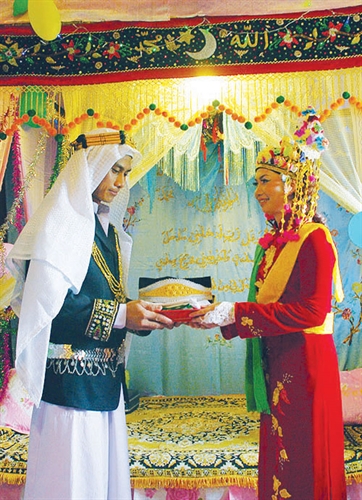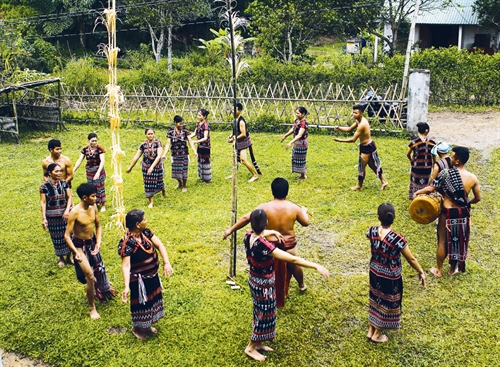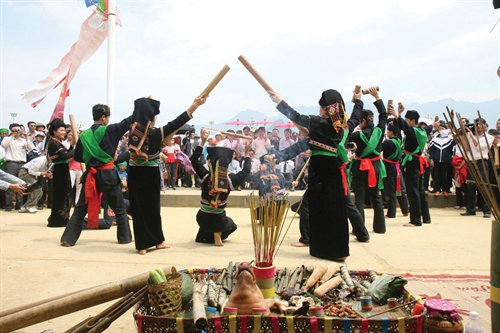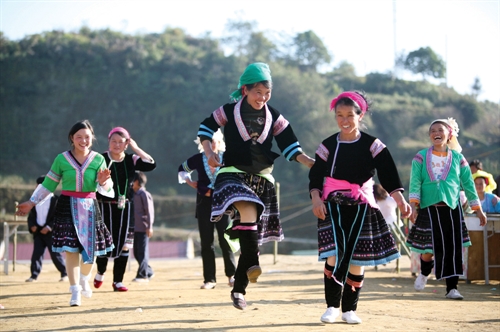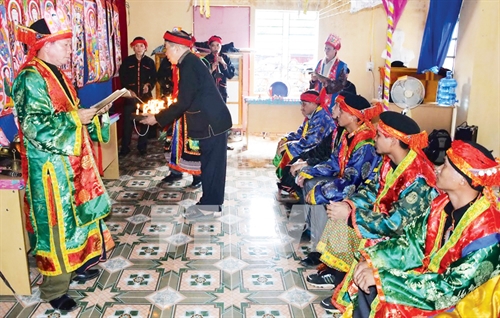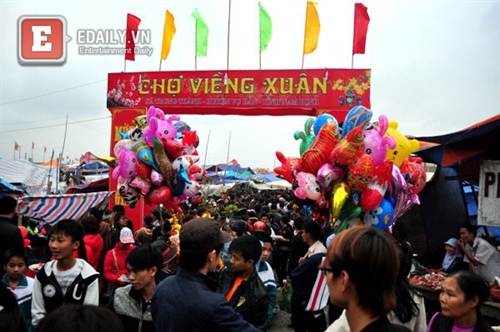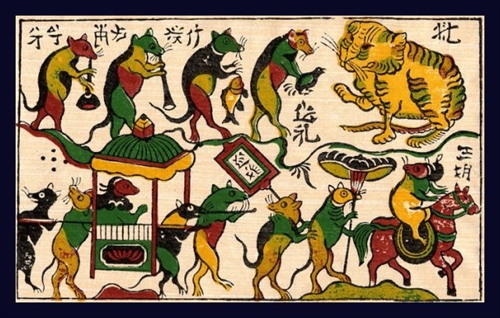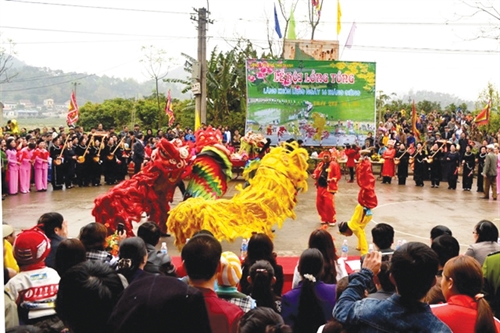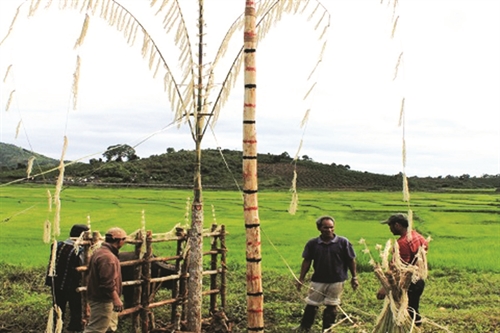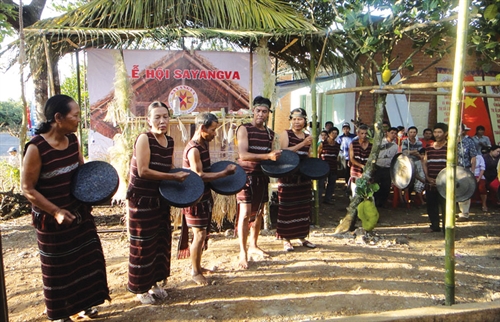>>The Gia Rai and its customary law
Ta Thi Tam
Ethnology Institute
The Gia Rai, also called Gio Rai, Cho Ray, To Buan, Mthun, Hbau, Hdrung, Chor or Gia Lai, is the largest one of the five groups of Malayo-Polynesian language family living along Se San, Ayun and Ia Pa river basins in the Central Highlands.
The group has a population of more than 411,270, according to the 2009 General Statistics Office data.
It is divided into five main subgroups living in different areas. Gia Rai Chor resides in Ayun Pa town, Phu Thien and Ia Pa districts, Gia Lai province; Gia Rai H’drung, in southern Kon Tum province, northeastern Pleiku city and Chu Pah, Chu Prong, Ia Grai and Dak Doa districts; and Gia Rai Arap, in northwestern Pleiku city and Chu Pah district, Gia Lai province. The other two subgroups Gia Rai Tbuan lives in Duc Co and Ida Grai districts, and Gia Rai Mthur, in Krong Pa district, in Gia Lai province.
The Gia Rai has a dozen of family names, including Rochom, Ksor, Siu, Ro o, Rahlan, Ramah, Nay, Hieu, Kpa, Pui, Ale, Ayun, Hwinh, etc. People of each family name have their own taboo. Rochom clan, for instance, has the taboo against eating cows while the Nay does not eat toads and the Ro o, not buffalos.
Gia Rai people live together in a village that is set up close to water sources and forests convenient for production. It used to have a nha rong (communal house) where community rituals and events were held, an entrance facing the north and a graveyard at the end of the village. Nowadays, its entrance faces the east and a graveyard is located at the west end of the village. People can enter a village from different directions and all houses in a village are surrounded by fences and face village roads. The size of a village depends on natural, land and economic conditions.
Each village has a patriarch selected from members of the village council who must be 40 years or older to take charge of village affairs such as naming the village, building houses for village members, organizing rituals and handling disputes according to the village’s customary laws.
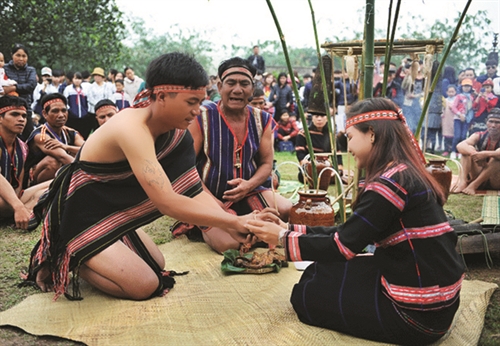 |
| Gia Rai couple exchange wedding bracelets__Photo: Internet |
The Gia Rai family
The Gia Rai customary laws ban the marriage between people bearing the same family name although they are not of the same blood line. However, a widow is permitted to marry an elder or younger brother of her deceased husband and similarly a widower is allowed to marry an elder or younger sister of his deceased wife if so agreed by the latter.
Divorce is not encouraged by the group. If the woman initiates the divorce, she must compensate her spouse with valuable property such as chieng (gong); if the husband initiates the divorce, he will be judged by the village. Persons who have out-of-wedlock children, illegal relationships and abortions will face severe punishment under Gia Rai customary laws.
The Gia Rai family is matriarchal with children bearing the mother’s family name. According to custom, the husband must stay with his wife’s family after marriage. Property is not given to the sons in the family when they are married, however the daughters are. The youngest girl who has the duty to look after the old parents is given a larger share. However, Gia Rai men are the families’ breadwinners and play a decisive role in social work.
According to customary laws, married couples must have their own children; if not, they have to adopt a child or pay a fine to the village or are even forced to leave the village. As a result, a Gia Rai family often has many children.
The Gia Rai livelihoods
This ethnic group has long practiced milpa and wet rice farming. They used to grow rice and sorghum as their main food crops. Rice is used to make ruou can (wine stored in a big jar and drunk with a long pipe) for daily use and rituals. Nowadays, they grow millet, maize, sweet potato and gourd. The Gia Rai prepares land for cultivation in the first or second lunar month, sows seeds in the third or fourth lunar month and harvests in the ninth or tenth lunar month. The group holds farming and other rituals in the 11th and 12th lunar months.
Every Gia Rai family has a garden surrounding their home for growing vegetables and fruits and raising cattle, poultry, pigs, buffalos, goat and horses. Cows are raised for plowing wet rice fields while buffaloes are raised for barter for valuable things such as chieng (gong), and horses are used in hunting, for transportation or barter for goods with traders from Laos and Cambodia. The Gia Rai used to raise elephants for transport but was not successful at taming them to catch wild ones so the group bartered them with neighboring traders for domesticated ones. Pigs, goats, chicken and ducks are raised for food, barter and religious rituals.
Apart from cultivation and husbandry, hunting, wild vegetable and fruit picking... play a certain part in their past life. Hunted animals and forest products help improve their daily meals.
Gia Rai men are good at carpentry, forging and knitting while women undertake weaving. The men make wood products such as rafters and beams for houses and knit bamboo and rattan and flax products like back baskets and rice baskets. Meanwhile, the women grow cotton, harvest and dry cotton bolls and dye fiber in black, red, yellow and blue.
Instead of using looms for weaving cloth, Gia Rai women use two bamboo sections, about 1.2 meter long each, with one section leaned against the weaver and the other hung fixed. Vertical yarns are stretched out to make a close circle with two layers separated by a string while horizontal yarns are made with bobbins. The group’s woven products include blankets, skirts, sleeveless blouse or long sleeve shirts and loincloths decorated with colorful images of humans, animals and landscapes.
In addition to traditional fiber, they now use industrial colorful threads and apply new weaving techniques to create diverse patterns on both sides of the cloth.
Traditionally, Gia Rai men wear V-shaped neck shirt and black indigo loincloths with colored lines while women wear round neck or boat neck sleeveless blouses with colored stripes and skirts wrapping around the belly down to the ankles. During festivals, both men and women wear long-sleeve decorated shirts. Men also wear colored and patterned loincloths and a body length black or white indigo scarf in cold weather.-
